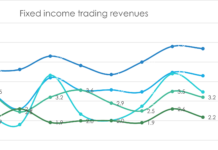
Using a blog post, Andrea Enria, chair of the Supervisory Board of the European Central Bank (ECB) has highlighted risks facing the sell-side around counterparty credit risk (CCR). The warning follows a recent series of regulatory interventions for sell-side firms based on concern around risks that dealers face, potentially becoming more systemic.
Enria noted that the search for yield in a low interest rate environment had “incentivised some banks to increase the volume of capital market services provided to riskier and less transparent counterparties, including non-bank financial institutions (NBFIs), such as hedge funds and family offices.”
The exposure to counterparty credit risk (CCR) thus became a supervisory priority for 2022 for the ECB, and it initiated a range of supervisory actions as countermeasures. After family office Archegos collpased, the ECB reviewed risk management practices from a sample of banks active in providing prime brokerage services. a specific capital markets activity with a high degree of CCR exposure and published recommendations on the topic in August 2022, then conducted a review of governance and CCR risk management 23 banks active in derivatives and securities financing transactions with non-banking counterparties, including firsm with exposure to energy and commodities.
“The review identified a number of good industry practices, but also several material shortcomings compared with supervisory expectations,” he wrote. “As a general remark, institutions need to go beyond mere compliance with regulatory requirements when designing their approaches, which should be proportionate to the scale and complexity of the business, products offered and the nature of the counterparties, as well as the need to keep pace with the increasingly fast moving and complex market situation.”
On client due diligence procedures, the ECB notes that failure to provide information should result in a more conservative approach to collateral, margining and limits, or rejection/offboarding of clients.
It also noted that banks with big or complex CCR exposures should specify acceptance of this risk in their risk appetite statement, rather than capturing it implicitly in credit risk.
“Banks also need to develop appropriate stress testing capabilities for CCR, with internal stress test results having an impact on risk monitoring and limits, with a particular focus on NBFIs. The scenarios in the stress testing framework for CCR should address not only counterparties’ creditworthiness, but also their vulnerability to bespoke exposure tail events, where such vulnerabilities can be magnified by combinations of high leverage, maturity mismatch, and non-linearities due to exposure to crowded trades.”
Following the UK’s mini-budget in September 2022, the country saw that leverage impacted pension funds with exposure to liability driven investment.
The ECB recommends that sell-side firms conduct more frequent stress tests to reflect a rapidly shifting risk environment, identifying counterparties whose solvency or liquidity position might come under pressure in certain market scenarios, and to detect concentration in exposure to margin shocks, a significant build-up in credit exposures, or vulnerabilities to rapid deleveraging. It also noted concern around wrong-way risk, in which a bank’s exposure to a counterparty increases with the risk of the counterparty’s default. Some minimum requirements for the identification, reporting and follow-up of wrong-way risk are set out in regulation, and banks should be ready to develop more sophisticated approaches if the nature of their business so requires. Added to that, Enria said the management of CCR when a counterparty is in trouble / defaulting needs work, particularly with over-the-counter (OTC) non-cleared derivatives.
“In many cases, static margins have not yet been replaced with more risk-sensitive arrangements,” he wrote. “Sometimes, legal terms even appeared to have been relaxed under commercial pressure. Early warning indicators specific to derivative and security financing transactions, such as discipline in collateral payments, are not always considered when compiling watchlists. Not all banks are testing the operational effectiveness of close-out procedures with regular “fire drills”. The management body and risk committee should be informed without delay of market tensions, major margin disputes, counterparties in difficulty and near misses observed by treasury and collateral management departments.”
The note from the ECB follows a warning from S&P Global that exposure to debt could also cause trouble for investors if a great debt ‘reset’ was needed to reflect the lower economics returns from debt, and concern from the UK’s Financial Conduct Authority (FCA) that liquidity risk management on the sell side had become weaker.
©Markets Media Europe, 2023
©Markets Media Europe 2025








